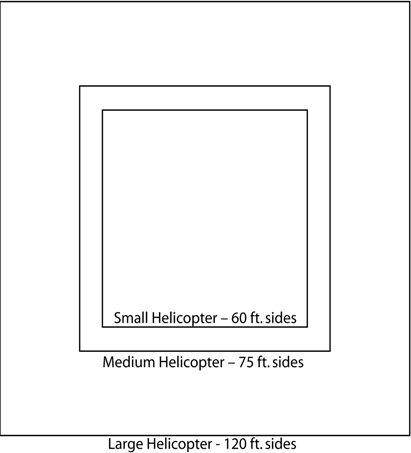Index
588
-- Page 589 --
590
12/10/15 AIM
b. The information provided is largely based on (a) Small Helicopter: Bell 206/407, Euro-
the booklet, LZ - Preparing the Landing Zone, issued copter AS-350/355, BO-105, BK-117.
by National Emergency Medical Services Pilots
(b) Medium Helicopter: Bell UH-1 (Huey)
Association (NEMSPA), and the guidance developed
and derivatives (Bell 212/412), Bell 222/230/430
by the University of Tennessee Medical Center's
Sikorsky S-76, Eurocopter SA-365.
LIFESTAR program, and is used with their
permission. For additional information, go to (c) Large Helicopter: Boeing Chinook,
http://www.nemspa.org/. Eurocopter Puma, Sikorsky H-60 series
(Blackhawk), SK-92.
c. Information concerning the estimation of wind
velocity is based on the Beaufort Scale. See 3. The LZ should be level, firm and free of loose
http://www.spc.noaa.gov/faq/tornado/beaufort.html debris that could possibly blow up into the rotor
for more information. system.
d. Selecting a Scene LZ 4. The LZ should be clear of people, vehicles
and obstructions such as trees, poles and wires.
1. If the situation requires the use of a helicopter,
Remember that wires are difficult to see from the air.
first check to see if there is an area large enough to
The LZ must also be free of stumps, brush, post and
land a helicopter safely.
large rocks. See FIG 10-2-5.
FIG 10-2-4
FIG 10-2-5
Recommended Minimum Landing Zone Dimensions
Landing Zone Hazards
5. Keep spectators back at least 200 feet. Keep
emergency vehicles 100 feet away and have fire
equipment (if available) standing by. Ground
personnel should wear eye protection, if available,
during landing and takeoff operations. To avoid loose
objects being blown around in the LZ, hats should be
removed; if helmets are worn, chin straps must be
securely fastened.
2. For the purposes of FIG 10-2-4 the follow-
ing are provided as examples of relative helicopter 6. Fire fighters (if available) should wet down
size: the LZ if it is extremely dusty.
Special Operations 10-2-11
 FIG 10-2-4
FIG 10-2-4
 FIG 10-2-5
Recommended Minimum Landing Zone Dimensions
Landing Zone Hazards
5. Keep spectators back at least 200 feet. Keep
emergency vehicles 100 feet away and have fire
equipment (if available) standing by. Ground
personnel should wear eye protection, if available,
during landing and takeoff operations. To avoid loose
objects being blown around in the LZ, hats should be
removed; if helmets are worn, chin straps must be
securely fastened.
2. For the purposes of FIG 10-2-4 the follow-
ing are provided as examples of relative helicopter 6. Fire fighters (if available) should wet down
size: the LZ if it is extremely dusty.
Special Operations 10-2-11
FIG 10-2-5
Recommended Minimum Landing Zone Dimensions
Landing Zone Hazards
5. Keep spectators back at least 200 feet. Keep
emergency vehicles 100 feet away and have fire
equipment (if available) standing by. Ground
personnel should wear eye protection, if available,
during landing and takeoff operations. To avoid loose
objects being blown around in the LZ, hats should be
removed; if helmets are worn, chin straps must be
securely fastened.
2. For the purposes of FIG 10-2-4 the follow-
ing are provided as examples of relative helicopter 6. Fire fighters (if available) should wet down
size: the LZ if it is extremely dusty.
Special Operations 10-2-11